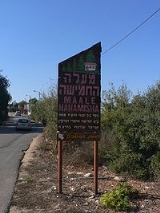
Ma'ale HaHamisha
Encyclopedia
Ma'ale Hahamisha is a kibbutz
in central Israel
. Located in the Judea
n hills just off the Jerusalem–Tel Aviv highway
, It falls under the jurisdiction of Mateh Yehuda Regional Council
. In 2007 it had a population of 352.
on 19 July 1938 as one of 57 tower and stockade
settlements founded almost overnight in the late 1930s and early 1940s to establish a permanent Jewish presence in Palestine in the face of Arab and British opposition. Five men from the kibbutz were ambushed and killed by Arab gunmen.
and old age payments, went into the kibbutz kitty, which supplied all necessities, communal and individual. The concept of sliding pay scales for different work — promoted primarily by the younger generation — had to be reconciled with the contributions of the veteran members.
The kibbutz struggled over the fate of community property. Members' apartments might be individually owned, but over the years, as the older generation remained in smaller units, bigger apartments were built for the younger generation and for a new familial sleeping scheme that had abandoned separate children’s houses. Members also had to decide what to do with the hotel and conference center.It took intervention by an outside arbitrator to reconcile the differences. In January 2005 the kibbutz was privatized.
The Main economic factor in the Kibbutz is the Ma'ale HaHamisha Hotel, and The Sakoya Events Compound.
Kibbutz
A kibbutz is a collective community in Israel that was traditionally based on agriculture. Today, farming has been partly supplanted by other economic branches, including industrial plants and high-tech enterprises. Kibbutzim began as utopian communities, a combination of socialism and Zionism...
in central Israel
Israel
The State of Israel is a parliamentary republic located in the Middle East, along the eastern shore of the Mediterranean Sea...
. Located in the Judea
Judea
Judea or Judæa was the name of the mountainous southern part of the historic Land of Israel from the 8th century BCE to the 2nd century CE, when Roman Judea was renamed Syria Palaestina following the Jewish Bar Kokhba revolt.-Etymology:The...
n hills just off the Jerusalem–Tel Aviv highway
Highway 1 (Israel)
Highway 1 , is the main highway connecting Tel Aviv with Jerusalem.-History:The section between Latrun and Jerusalem roughly follows an ancient path connecting Jaffa and Jerusalem...
, It falls under the jurisdiction of Mateh Yehuda Regional Council
Mateh Yehuda Regional Council
Mateh Yehuda Regional Council is a regional council in the Jerusalem District of Israel. In 2008 it was home to 36,200 people.The name of the regional council stems from the fact that its territory was part of the land allotted to the Tribe of Judah, according to the Bible.-Places and...
. In 2007 it had a population of 352.
History
The kibbutz was founded by members of the Gordonia youth movementGordonia youth movement
Gordonia was a Zionist youth movement. The movement's doctrines were based on the beliefs of Aaron David Gordon, i.e. the salvation of Eretz Yisrael and the Jewish People through manual labor and the revival of the Hebrew language...
on 19 July 1938 as one of 57 tower and stockade
Tower and stockade
Tower and stockade was a settlement method used by Zionist settlers in the British Mandate of Palestine during the 1936–39 Arab revolt, when the establishment of new Jewish settlements was restricted by the Mandatory authorities...
settlements founded almost overnight in the late 1930s and early 1940s to establish a permanent Jewish presence in Palestine in the face of Arab and British opposition. Five men from the kibbutz were ambushed and killed by Arab gunmen.
Economy
The kibbutz originally supported itself primarily on agriculture and developed both the Ma'ale HaHamisha cauliflower and peach, as well as gaining income from a hotel. In the early 2000s, the main issue in privatization of the kibbutz was what type of financial and social change could take place. Until then, all sources of income, including German reparationsReparations Agreement between Israel and West Germany
The Reparations Agreement between Israel and West Germany was signed on September 10, 1952, and entered in force on March 27, 1953...
and old age payments, went into the kibbutz kitty, which supplied all necessities, communal and individual. The concept of sliding pay scales for different work — promoted primarily by the younger generation — had to be reconciled with the contributions of the veteran members.
The kibbutz struggled over the fate of community property. Members' apartments might be individually owned, but over the years, as the older generation remained in smaller units, bigger apartments were built for the younger generation and for a new familial sleeping scheme that had abandoned separate children’s houses. Members also had to decide what to do with the hotel and conference center.It took intervention by an outside arbitrator to reconcile the differences. In January 2005 the kibbutz was privatized.
The Main economic factor in the Kibbutz is the Ma'ale HaHamisha Hotel, and The Sakoya Events Compound.

